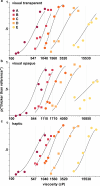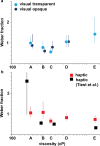Both optical and rheological properties contribute to viscosity judgements when comparing real liquids using vision and touch
- PMID: 40012753
- PMCID: PMC11858744
- DOI: 10.1098/rsos.241170
Both optical and rheological properties contribute to viscosity judgements when comparing real liquids using vision and touch
Abstract
Does the opacity of a liquid, or the way it reflects light, affect how viscous it appears? Would the perceived viscosity change if we touch the liquid? Viscosity of a material, or how it flows, produces a rich stimulus that reflects the material's rheological properties, which can be independently inferred by touch or vision, or by combining modalities. In addition, the material's optical properties convey other cues not dependent on rheology, such as colour or transparency. How these multisensory cues form stable percepts of viscosity that drive behaviour remains unknown. To shed light on this mapping, we conducted a series of psychophysical experiments in which observers compared the thickness of real liquids. First, we show that perceptual discrimination tends to scale in proportion to stimulus viscosity. Next, we show that optical properties such as transparency and opacity, although not related to viscosity, influence visual judgments of thickness. This bias, driven by appearance, is reduced when observers combine visual and haptic information. Combining information across visual and haptic senses improves discrimination only over a limited viscosity range.
Keywords: Weber fraction; haptic; perception; psychophysics; viscosity; visual.
© 2025 The Author(s).
Conflict of interest statement
We declare we have no competing interests.
Figures






References
-
- Coppen FMV. 1942. The differential threshold for the subjective judgement of the elastic and plastic properties of soft bodies. Br. J. Psychol. Gen. Sect. 32, 231–247. (10.1111/j.2044-8295.1942.tb01022.x) - DOI
-
- Scott Blair G, Coppen FMV. 1939. The subjective judgement of the elastic and plastic properties of soft bodies; the ‘differential thresholds’ for viscosities and compression moduli. Proc. R. Soc. Lond. B 128, 109–125. (10.1098/rspb.1939.0046) - DOI
-
- Harper R, Stevens SS. 1964. Subjective Hardness of Compliant Materials. Q. J. Exp. Psychol. 16, 204–215. (10.1080/17470216408416370) - DOI
Associated data
LinkOut - more resources
Full Text Sources

